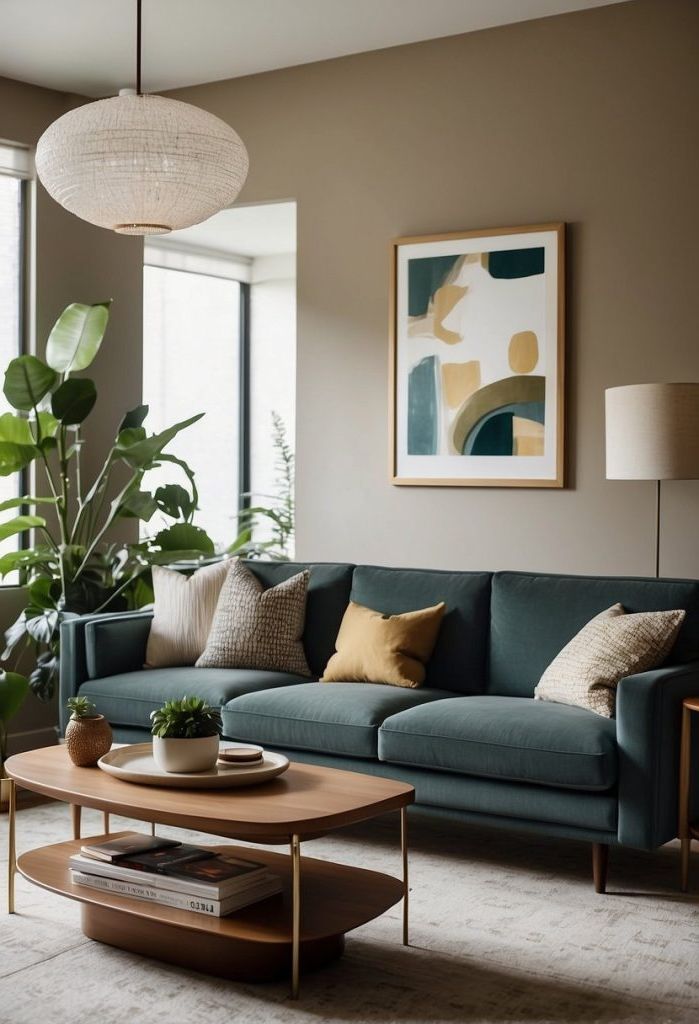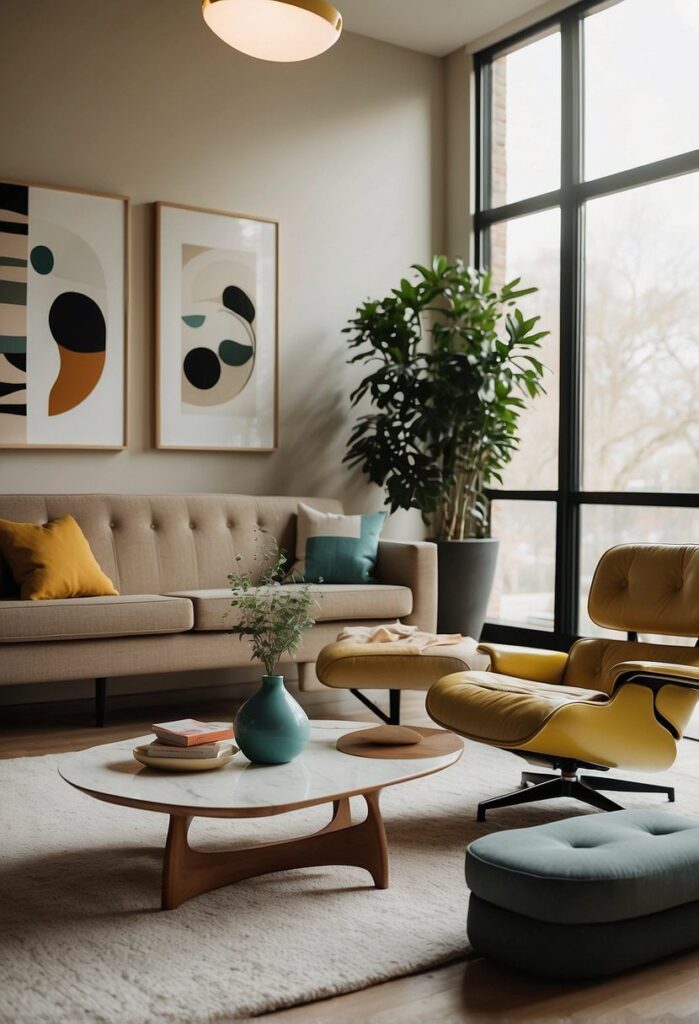Have you heard of mid-century modern style? It’s a super cool design trend that became popular in the mid-20th century. People love it because it’s all about keeping things simple and practical.
This style really brings together both architectural and interior design elements – think clean lines, natural shapes, and a perfect blend of form and function.
It’s all about creating a seamless and balanced look that just works.

So, back in the day, designers used stuff like wood, metal, and glass to create that cool mid-century modern look.
The goal was to make rooms feel clean, organized, and all in tune with nature.

A hallmark of mid-century modern interior design is the innovative use of traditional materials and the introduction of new ones, often resulting in a celebration of contrasting textures and colors that are still appreciated today.
In the mid-century modern movement, they really focused on bringing nature inside by using big windows and open layouts to connect the inside of homes with the outside world.
They wanted everyone to be able to live in style, so they made sure their designs were affordable and accessible, which ended up influencing how people live all over the world.
Key Takeaways
- Mid-century modern is a design style known for its simple, functional aesthetic and use of contrasting materials.
- The style is prevalent in both architectural form and interior design, featuring clean lines and organic shapes.
- Mid-century modern design principles prioritize functionality, affordability, and a strong connection with the natural environment.
Historical Context

Mid-century modern style emerged as a distinctive aesthetic in the mid-20th century, shaped largely by the aftermath of World War II and characterized by a blend of functionality, comfort, and artistic flair.
It marked a departure from traditional design towards a new, modern approach influenced by technology and production.
Origins of Mid-Century Modern Style
So, you know that term “mid-century modern” we hear a lot these days? Well, fun fact, it actually became trendy back in the 1980s, but the style dates all the way back to the 1930s.
People were looking for something sleek, simple, and practical that could be easily made in large quantities. And that’s how mid-century modern came to be!
Post-War Influences
The end of World War II had a big impact on design. After the war was over, there was a feeling of starting fresh in both Europe and the United States.
This led to a new way of thinking about industrial design, with a focus on making things in large quantities.
Mid-century modern furniture was a reflection of the practical needs of the time, but it also brought a sense of hope and a modern touch to people’s homes.
Notable Designers and Architects
The mid-century modern style that we love so much today was actually shaped by some pretty cool visionaries!
People like Charles and Ray Eames, Frank Lloyd Wright, Eero Saarinen, and Ludwig Mies Van Der Rohe were the brains behind it all.
They were the ones who brought in new materials and techniques that really set the tone for the architecture and design of that era.
The Bauhaus movement, guided by folks like Walter Gropius, was all about creating designs that were practical and easy to use.
On the other hand, Scandinavian design, championed by trailblazers like Alvar Aalto, focused on the elegance of simplicity and using natural materials.
These ideas were super important in shaping the look of mid-century modern styles.
Mid-Century Modern in Media
Have you seen shows like “Mad Men”? They really put mid-century modern back in the spotlight and show how timeless it is.
It’s cool to see this style making a comeback in media and how it still influences modern design today.
Aesthetics and Characteristics

Mid-Century Modern (MCM) style is distinguished by several key aesthetic principles and characteristics.
The movement emphasizes functionality, clean lines, and the seamless integration of both organic and geometric forms.
Key Elements of Design
Mid-Century Modern design champions simplicity and minimalism. Features include:
- Clean lines: Smooth, sleek lines that are both sophisticated and understated.
- Geometric shapes mixed with organic forms, achieving a functional yet visually striking balance.
Materials and Textures
The textures and materials selected for MCM underscore the connection with nature and a penchant for combining different elements:
- Predominantly made of wood, like teak and walnut, often complemented by glass, steel, and natural materials.
- Bent plywood and upholstery fabrics are commonly used in furniture design.
Architectural Features
Have you ever noticed how Mid-Century Modern architecture has some really cool and unique features?
- Open floor plans and ranch-style designs are emblematic of the era.
- Large floor-to-ceiling windows and glass doors blur the boundary between indoors and outdoors.
Furniture and Decor
Iconic MCM furniture merges form with function:
- The Eames chair, egg chair, and Danish modern pieces highlight multipurpose furniture.
- Accent pieces often serve a dual role as functional items and works of art.
Color and Patterns
I love how the colors and patterns in MCM design are so bold, but still manage to be perfectly balanced. It really gives the space a cool vibe, don’t you think?
- The color palette consists of both muted tones and bold colors, reflecting the era’s characteristic contrast.
- Patterns are often graphic in nature, with an emphasis on both asymmetry and rhythm.
Functionality and Comfort

Mid-century modern style prioritizes functionality in design while maintaining comfort for the user.
The core essence lies in the creation of simple, yet highly functional furniture and living spaces that are designed for everyday use.
Form and Function
In mid-century modern design, the form of an object is inherently linked with its function.
Designers emphasized structures that were functional as well as aesthetically pleasing, adhering to the principle that beauty should follow function.
Furniture from back in the day had these cool lines and curves that were all about making things comfy and ergonomic. They were all about function and practicality!
Practical Innovations
During this time, designers really stepped up their game by coming up with some cool new ideas for making things comfy and stylish at the same time.
The introduction of new materials and techniques in mass production enabled more organic shapes, which were not only visually appealing but also provided greater comfort.
One can observe that sofas and chairs often had curved contours, fitting the human body more naturally.
Design for the Masses
Back in the day, those mid-century modern designers were all about making cool furniture that everyone could actually afford.
They figured out ways to mass-produce their designs, which made them super accessible to a lot more people.
And you know what? It actually brought down costs so everyone could enjoy high-quality, stylish furniture without breaking the bank.
You know, a lot of people just love those original mid-century pieces. But hey, there are also these cool replicas out there that are bringing that stylish vibe into more homes.
It’s like getting the look you want without breaking the bank, you know?
Global Influence and Legacy

The mid-century modern style has really made a mark on architecture and design worldwide. It’s left a lasting legacy that we can still see today in preservation projects and current trends.
You can see its impact in iconic buildings and even in how people decorate their homes today.
Preservation and Restoration
Have you ever noticed those cool mid-century modern buildings in Palm Springs? They’re like treasured pieces of history, with their unique designs and retro vibes.
Architects like Richard Neutra and John Lautner really captured the essence of that time period. It’s so awesome to see how people are working hard to preserve these iconic structures for future generations to enjoy.
Have you ever seen the Elrod House by Lautner? It’s such a great example of how the architecture blends in perfectly with the natural surroundings.
Preservationists are really big fans of these special homes, especially those designed by famous architects like Neutra and A.
Quincy Jones. They do a lot to make sure these gems are well taken care of for future generations to enjoy.
Modern Interpretations
Modern designers today are really into the whole mid-century vibe – you know, that whole minimalist and functional style. Scandinavian design is also a big deal right now, with its clean lines and natural shapes.
It’s so cool how both of these styles are still making a mark on how we decorate our homes in Europe and America.
When it comes to designing hotels and commercial spaces, the focus is on keeping things simple yet cozy, taking inspiration from the past.
This comeback of minimalist design pays homage to its origins while also catering to our current need for eco-friendly and functional living spaces.
Significant Structures
Around the world, there are some really cool buildings that show how awesome the mid-century modern style is.
One of the architects who nailed this style is Pierre Koenig, especially with his Case Study Houses.
These houses are all about that sleek international look and the cool idea of blending indoor and outdoor living seamlessly.
Have you ever heard of the Farnsworth House? It was designed by an architect called Mies van der Rohe and it’s super famous for representing some important architectural principles.
Some other architects like E. Stewart Williams and William Krisel have also made a big impact with their work.
Their legacy is still really popular today and has had a big influence on modern architecture. It’s pretty cool, right?
Frequently Asked Questions

In this part, we’ve got you covered with quick answers to all your burning questions about mid-century modern style.
We’ll break down the design elements and share some cool facts about its history. So, let’s dive in and explore this awesome style together!
How can I identify a mid-century modern style living room?
So, like, a mid-century modern living room is all about those sleek lines, cool shapes, and a combo of different materials like wood, metal, and glass.
Oh, and don’t forget about the furniture with those tapered legs and simple designs – total classics for this vibe!
What are the defining characteristics of mid-century modern interior design?
Some important things to know about this style are that it’s all about keeping things practical and simple, with a touch of nature brought in through big windows and lots of greenery inside.
The color schemes usually mix calm, neutral colors with a pop of something vibrant.
What makes a piece of furniture distinctly mid-century modern?
Distinct features of mid-century modern furniture are streamlined shapes, natural wood hues paired with colorful upholstery, and a blend of traditional craftsmanship with industrial techniques.
In what ways did mid-century modern architecture stand out from other architectural styles?
Mid-century modern architecture is known for its flat planes, big windows, and open layouts that flow easily from inside to outside.
It’s all about bringing the outdoors in and creating a seamless living experience.
Can you describe the historical context of mid-century modern interior design?
So, back in the mid-20th century, after World War II, people were really into this cool design style called mid-century modern.
It was all about creating homes and furniture that were trendy and easy to get your hands on.
What sets mid-century modern graphic design and art apart from other artistic movements?
The graphic design and art from the mid-century modern era really stood out with their bold and simplified shapes and colors. They often portrayed themes inspired by the Atomic Age and space exploration.



